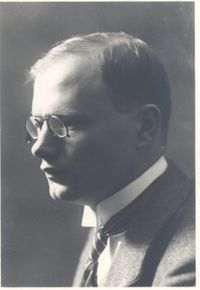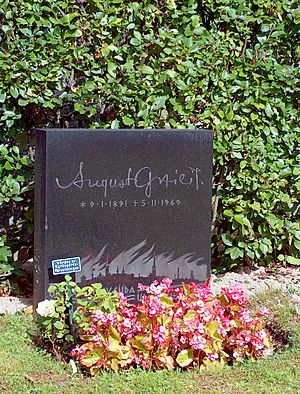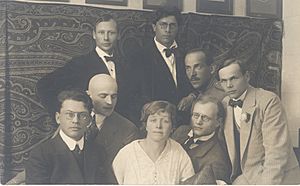August Gailit facts for kids
Quick facts for kids
August Gailit
|
|
|---|---|
 |
|
| Born | 9 January 1891 Sangaste Parish (now Otepää Parish), Kreis Dorpat , Governorate of Livonia, Russian Empire
|
| Died | 5 November 1960 (aged 69) Örebro, Örebro County, Sweden
|
| Occupation | Writer |
| Years active | 1916–1960 |
August Gailit (born January 9, 1891 – died November 5, 1960) was a famous Estonian writer. He is best known for his exciting novels and short stories. His most famous book, Toomas Nipernaadi, tells the tale of a wandering adventurer.
Contents
Life of August Gailit
August Gailit was born on January 9, 1891. His full name was Georg August Gailit. He grew up in a small village called Kuiksilla, near Sangaste Castle in Estonia. His father was a carpenter.
Early Life and Education
August went to school in his local area starting in 1899. Later, he attended schools in the towns of Valga and Tartu. These schools helped him learn and grow.
Becoming a Journalist
From 1911 to 1914, August Gailit worked as a journalist. He wrote for newspapers in both Latvia and Estonia. He continued this work from 1916 to 1918. During the Estonian War of Independence, he reported on the war as a correspondent. This meant he wrote about what was happening during the conflict.
Life as a Writer
After the war, August Gailit traveled a lot. From 1922 to 1924, he lived in Germany, France, and Italy. When he returned to Estonia, he became a full-time writer. He lived in Tartu and later moved to Tallinn in 1934. For a few years, from 1932 to 1934, he was also the director of the Vanemuine Theater in Tartu.
Family Life and Moving to Sweden
In 1932, August Gailit married an actress named Elvi Vaher-Nander. They had a daughter, Aili-Viktooria, in 1933.
In 1944, during the Soviet occupation of Estonia, August Gailit and his family had to leave their home. They moved to Sweden to find safety. He continued to write there. They settled in a place called Ormesta manor house, near Örebro. August Gailit passed away in Örebro on November 5, 1960. He was buried in the Örebro northern cemetery.
August Gailit's Literary Career
August Gailit was part of a group of writers and artists called Siuru. This group was formed in 1917. Other famous members included Marie Under and Friedebert Tuglas.
Writing Style and Influences
In his early career, Gailit's writing was often influenced by a style called neo-romanticism. This style focused on emotions, imagination, and adventure. Other writers like Oswald Spengler and Knut Hamsun also had a big impact on his work.
Famous Novels
One of August Gailit's most famous novels is Toomas Nipernaadi. This book tells the story of a romantic and adventurous wanderer. It was so popular that it was even made into a movie in 1983!
He also wrote novels that touched on important events. For example, Isade maa (published in 1935) was about the Estonian War of Independence from 1918 to 1920. Another novel, Üle rahutu vee (published in 1951), explored the sad experience of people having to leave their homeland.
Selected Works

Here are some of August Gailit's important works:
- Kui päike läheb looja (a tale, 1910)
- Saatana karussell (a collection of novels, 1917)
- Muinasmaa (a novel, 1918)
- Klounid ja faunid (a serial story, 1919)
- Rändavad rüütlid (a collection of novels, 1919)
- August Gailiti surm (a collection of novels, 1919)
- Purpurne surm (a novel, 1924)
- Idioot (a collection of novels, 1924)
- Vastu hommikut (a collection of novels, 1926)
- Aja grimassid (a serial story, 1926)
- Ristisõitjad (a collection of novels, 1927)
- Toomas Nipernaadi (a novel, 1928)
- Isade maa (a novel, 1935)
- Karge meri (a novel, 1938)
- Ekke Moor (a novel, 1941)
- Leegitsev Süda (a novel, 1945)
- Üle rahutu vee (a novel, 1951)
- Kas mäletad, mu arm? (prose, 3 volumes, 1951–1959)


